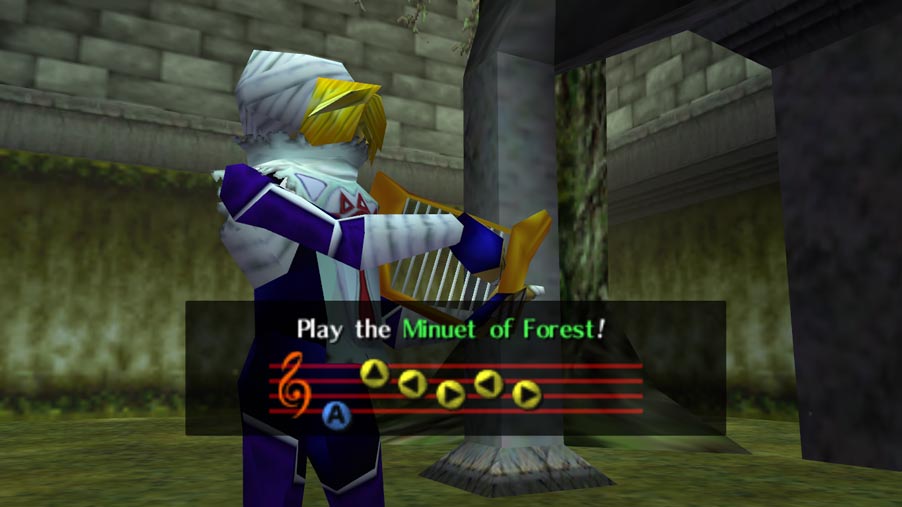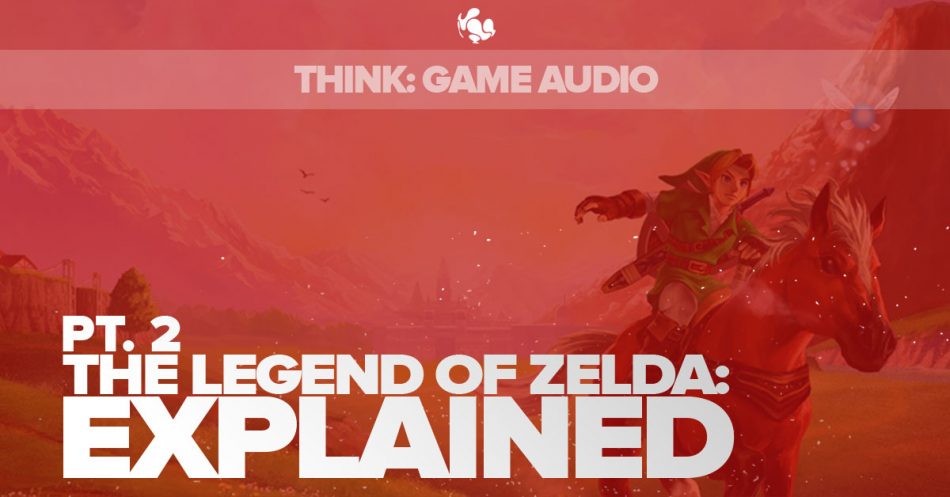This is Part Two in our music lessons from Ocarina of Time. Make sure you read Part One first!
Last time, we saw how Song of Time and Serenade of Water use the Dorian mode, and how Saria’s Song uses the Lydian Mode. In this blog, we’ll be looking at Song of Storms and Minuet of Forest, their interesting use of some familiar scales and how they’re harmonised.

Song of Storms
Like Serenade of Water, the main theme of Song of Storms is based on a D minor arpeggio (Serenade of Water is D – F – A, Song of Storms is D – F and D the octave above). But where Serenade of Water moves straight to the major sixth of the scale and establishes Dorian as the mode (as you’ll remember from last time the major sixth is what gives the Dorian its distinctive flavour), in Song of Storms the sixth is not sounded in the melody and is only played in the harmony, and alternates between the major and the minor.
So if the sixth changes between major and minor, is this Dorian or Aeolian? (As you should remember from last time, Aeolian is another name for the minor scale) I think it’s Aeolian. Let’s get in to why that is.
Warning: Now we must delve more deeply in to the murky waters of music theory, so be prepared. But don’t worry too much, I’ll explain everything as we go along.

Let’s get in to the harmony. So, Song of Storms is in D minor, and in D minor the chord built diatonically on the supertonic position is a diminished triad, but as we see from the chords above the stave, here we have the chromatic use of an E minor chord. (I know I know, there was a lot of fancy terms in there, so let’s go through them all)
Diatonic means to only use notes within the key or scale you are using. So if you are playing diatonically within the key of D minor, you are only using the notes found in D minor. If you use notes found outside the key, they are said to be chromatic. So the E minor in this case is a chromatic chord because it has a B natural in it (B is flat in D minor). Remember, not all the notes in a chord need to be from another key for the chord itself to be considered chromatic, just one will do.
Why use chromaticism? We get this word from the greek Chromatikos, which means colour. This is because it makes your music sound more colourful. You may think this is an odd description, but if you listen to music with chromatic elements (essentially all classical music) you should understand. If you’d like to get a better understanding of harmony, check out our Harmony Courses here.
Major and minor scales have seven notes, and there are seven different names for the scale positions. They are, from bottom to top, Tonic, Supertonic, Mediant, Subdominant, Dominant, Submediant and Leading Note (in a minor scale the seventh has to be sharpened to be considered a Leading note). So when I said a chord built on the supertonic position, I mean a chord built on the second degree of the scale. (I think that just about clears everything up!)
Putting a minor triad (triad is the name for a 3 note chord) on the second degree of your minor scale instead of a diminished triad is a fairly common way of introducing a little chromaticism to your music. To use an example from popular music, this is exactly what happens in the opening chords to Michael Jackson’s Billie Jean.
So why would I say this Aeolian not Dorian? The B natural in the E minor chord is really more of a passing note to add a little colour, and the minor six is very much more firmly established in the B flat major chords that follow the F major, so this has a more typical minor tonality. So it would be wrong to say that this is Dorian, but more Aeolian with a chromatic passing note. The major sixth would have to be more present in the melody before you could say it was Dorian.

Minuet of Forest
Just as Song of Storms uses chromatic harmony to make the Aeolian scale more interesting, Minuet of Forest does the same with the Ionian scale (which, again, you should remember, is another name for the major scale). Both of these melodies are completely diatonic, but are enriched by their harmony.
But this one does something even more interesting: it changes key with the chromatic harmony in the new key. What exactly do I mean by this? Let’s go in to more detail.

Minuet of Forest starts in D major. The opening chords, E minor 7 and A major, are the chords built on the second and fifth position of D major. 2 – 5 – 1s are a very common chord progression and quickly establish the key. So common are they in fact, that even though in this case the 1, D major, is not played, it is implied by the 2 and 5, because we are so used to hearing this progression.
What happens next? The tune modulates to E major (modulate just means to change key), as you can see from the E major chord it finishes on. So what’s up with the C major and D major? C and D are both sharp in the key of E, so these chords are definitely chromatic.
This is another common chromatic chord pattern. The sixth and seventh position of the major scale, which diatonically in E would be C sharp and D sharp, are flattened, and have major triads put on them. If you wanted to think of this in C major to make it more clear, the chords would be A flat major – B flat major – C major. This exact chord pattern comes up in the Super Mario Bros. theme, which Kondo also composed, so he clearly likes this progression. To use an example from popular music again, this is the same chord progression that begins Lola by The Kinks. This chord pattern is often used as a substitute for a perfect cadence (V – I chord progression, or dominant to tonic), and perfect cadences are a perfect way of establishing a new key, which is why this works well modulating to E. This chord progression is much more commonly found in popular music than classical.
So what have we learned? Even fairly simple melodies based on standard minor and major scales can be made so much more rich and interesting through the use of good harmony. If you want to add a little colour to your music (which you should), try adding some chromatic harmony. Some common chromatic chord progressions you can try out are the minor supertonic chord in a minor key, and major triads on the flattened sixth and seventh positions in a major key. Play around with them and see how they sound to you.
There are of course almost limitless ways of bringing chromaticism to your music, but that’s all we have time for today! If you enjoyed this lesson, make sure you check out our other blogs, and stay tuned for further lessons. If you’re serious about furthering your knowledge and your career in music, check out our Postgraduate and Premium courses on our website and see which ones are suitable for you. We’re always happy to help, so send us an email at contact@thinkspace.ac.uk with any questions and we’ll get back to you.

